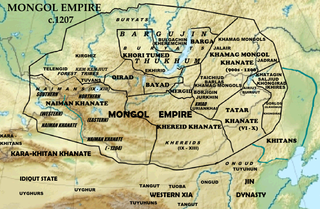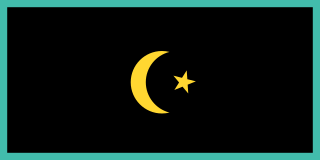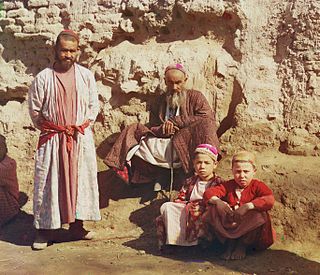
The history of the Kyrgyz people and the land now called Kyrgyzstan goes back more than 3,000 years. Although geographically isolated by its mountainous location, it had an important role as part of the historical Silk Road trade route. Turkic nomads, who trace their ancestry to many Turkic states such as the First and Second Turkic Khaganates, have inhabited the country throughout its history. In the 13th century, Kyrgyzstan was conquered by the Mongols; subsequently it regained independence but was invaded by Kalmyks, Manchus and Uzbeks. In 1876 it became part of the Russian Empire, remaining in the USSR as the Kirghiz Soviet Socialist Republic after the Russian Revolution. Following Mikhael Gorbachev's democratic reforms in the USSR, in 1990 pro-independence candidate Askar Akayev was elected president of the SSR. On 31 August 1991, Kyrgyzstan declared independence from Moscow, and a democratic government was subsequently established.

Uzbekistan is a landlocked country in Central Asia. It is itself surrounded by five landlocked countries: Kazakhstan to the north; Kyrgyzstan to the northeast; Tajikistan to the southeast; Afghanistan to the south, Turkmenistan to the south-west. Its capital and largest city is Tashkent. Uzbekistan is part of the Turkic languages world, as well as a member of the Organization of Turkic States. While the Uzbek language is the majority spoken language in Uzbekistan, Russian is widely used as an inter-ethnic tongue and in government. Islam is the majority religion in Uzbekistan, most Uzbeks being non-denominational Muslims. In ancient times it largely overlapped with the region known as Sogdia, and also with Bactria.
The Uzbeks are a Turkic ethnic group native to wider Central Asia, being the largest Turkic ethnic group in the area. They comprise the majority population of Uzbekistan but are also found as a minority group in: Afghanistan, Tajikistan, Kyrgyzstan, Kazakhstan, Turkmenistan, Russia, Pakistan, and China. Uzbek diaspora communities also exist in Turkey, Saudi Arabia, United States, Ukraine, and other countries.

The Chagatai Khanate, or Chagatai Ulus, was a Mongol and later Turkicized khanate that comprised the lands ruled by Chagatai Khan, second son of Genghis Khan, and his descendants and successors. At its height in the late 13th century the khanate extended from the Amu Darya south of the Aral Sea to the Altai Mountains in the border of modern-day Mongolia and China, roughly corresponding to the area once ruled by the Qara Khitai.

Abdullah Khan (1533/4–1598), known as "The old Khan", was an Uzbek ruler of the Khanate of Bukhara (1500–1785). He was the last Shaybanid Khan of Bukhara from 1583 until his death.

The Naiman were a medieval tribe originating in the territory of modern Western Mongolia, and are one of the tribes of modern Mongols and in the middle juz of the Kazakh nation.
The Karluks were a prominent nomadic Turkic tribal confederacy residing in the regions of Kara-Irtysh and the Tarbagatai Mountains west of the Altay Mountains in Central Asia. They were also known as the Géluólù. Karluks gave their name to the distinct Karluk group of the Turkic languages, which also includes the Uyghur, Uzbek and Ili Turki languages.

The Khanate of Khiva was a Central Asian polity that existed in the historical region of Khwarezm in Central Asia from 1511 to 1920, except for a period of Afsharid occupation by Nader Shah between 1740 and 1746. Centred in the irrigated plains of the lower Amu Darya, south of the Aral Sea, with the capital in the city of Khiva, the country was ruled by a Turco-Mongol tribe, the Khongirads, who came from Astrakhan. It covered present western Uzbekistan, southwestern Kazakhstan and much of Turkmenistan before Russian arrival at the second half of the 19th century.

The Khanate of Bukhara was an Uzbek state in Central Asia from 1500 to 1785, founded by the Abu'l-Khayrid dynasty, a branch of the Shibanids. From 1533 to 1540, Bukhara briefly became its capital during the reign of Ubaydallah Khan. The khanate reached its greatest extent and influence under its penultimate Abu'l-Khayrid ruler, the scholarly Abdullah Khan II.

Sart is a name for the settled inhabitants of Central Asia which has had shifting meanings over the centuries. Sarts, known sometimes as Ak-Sart in ancient times, did not have any particular ethnic identification, and were usually town-dwellers.

The Kazakh Khanate was a Kazakh state in Central Asia, successor of the Golden Horde existing from the 15th to 19th century, centered on the eastern parts of the Desht-i Qipchaq.

Soviet Central Asia was the part of Central Asia administered by the Soviet Union between 1918 and 1991, when the Central Asian republics declared independence. It is nearly synonymous with Russian Turkestan in the Russian Empire. Soviet Central Asia went through many territorial divisions before the current borders were created in the 1920s and 1930s.
The Mangghud, or Manghud, were a Mongol tribe of the Urud-Manghud federation. They established the Nogai Horde in the 14th century and the Manghit dynasty to rule the Emirate of Bukhara in 1785. They took the Islamic title of Emir instead of the title of Khan, since they were not descendants of Genghis Khan and rather based their legitimacy to rule on Islam. The clan name was used for Mongol vanguards as well. Their descendants live in several regions of the former Mongol Empire.
A khaganate or khanate was a political entity ruled by a khan, khagan, khatun, or khanum. This political entity was typically found on the Eurasian Steppe and could be equivalent in status to tribal chiefdom, principality, kingdom or empire.

Moghulistan, also called the Moghul Khanate or the Eastern Chagatai Khanate, was a Mongol breakaway khanate of the Chagatai Khanate and a historical geographic area north of the Tengri Tagh mountain range, on the border of Central Asia and East Asia. That area today includes parts of Kazakhstan, Kyrgyzstan, and northwest Xinjiang, China. The khanate nominally ruled over the area from the mid-14th century until the late 17th century.

The Khongirad, also known as Qongirat (Qoŋğırat/Қоңғырат), was one of the major divisions of the Mongol tribes. Variations on the name include Onggirat, Ongirat, Qongrat, Khungirat, Kungrad, Qunghrãt, Wangjila (王紀剌), Yongjilie (雍吉烈), Qungrat, and Guangjila (廣吉剌) in Chinese sources. Their homeland was located in the vicinity of Lake Hulun in Inner Mongolia and Khalkha River in Mongolia, where they maintained close ties with the ruling dynasties of northern China. Because the various Hongirad clans never united under a single leader, the tribe never rose to great military glory. Their greatest fame comes from being the primary consort clan of the ruling house of Genghis Khan's Mongol empire. Genghis Khan's mother (Hoelun), great grandmother, and first wife were all Khongirads, as were many subsequent Mongol queens and princesses.
The Young Bukharans or Mladobukharans were a secret society founded in Bukhara in 1909, which was part of the jadidist movement seeking to reform and modernize Central Asia along Western-scientific lines.
Jalair, also Djalair, Yyalair, Jalayir, is one of the Darliqin Mongol tribes according to Rashid-al-Din Hamadani's Jami' al-tawarikh. They lived along the Shilka River in modern Zabaykalsky Krai of Russia. After the Mongol conquest in the 13th century many Jalairs spread over Central Asia and the Middle East. Jalairs are one of the founding tribes of Mongolia's largest ethnic group Khalkha. Smaller clans named Jalayir are also found in Inner Mongolia in China. The Jalayirs who stayed in Central Asia under the rules of Genghis Khan's older sons' descendants eventually adopted Turkic language. They are found among the Kazakhs of the Great jüz; also they are found among the Uzbeks, Karakalpaks, and the Kyrgyz. The Jalairs who went to Iran and Iraq found the Jalairid Sultanate in 1330, and expanded into Turkey. The state was subjugated by the Kara Koyunlu in 1432.
The Karluk Yabghu State was a polity ruled by Karluk tribes.
Shir Ali Khan was the Khan of Kokand from June 1842 to 1845. He belonged to the Ming tribe that ruled Kokand.










